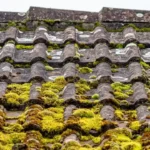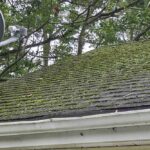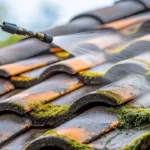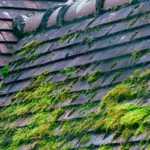When it comes to maintaining a home, one of the most overlooked areas is the roof. Many homeowners don’t realize the potential damage that can occur from seemingly harmless roof moss and moisture problems. This guide aims to educate you on the importance of addressing these issues promptly to protect your home and investment.

Understanding Roof Moss
Roof moss is a common issue, particularly in regions with high humidity and shade. This green, velvety plant thrives in damp environments and can quickly spread across your roof, leading to various moisture problems.
How Does Moss Affect Your Roof?
Moss can cause significant damage to your roof by trapping moisture, which can lead to rot and decay of roofing materials. The presence of moss can also lift shingles, creating gaps where water can seep in, potentially causing leaks and water damage inside your home.
Signs of Roof Moss and Moisture Issues
It’s crucial to regularly inspect your roof for signs of moss and moisture. Look for green patches, lifted or missing shingles, and water stains on your ceiling. Early detection can save you from costly repairs.
Addressing Moisture Problems
Moisture is a roof’s worst enemy. It can lead to mold growth, structural damage, and a host of other issues. Understanding how moisture affects your roof and taking steps to manage it can preserve the integrity of your home.
The Importance of Proper Ventilation
One of the most effective ways to combat moisture problems is by ensuring your roof has proper ventilation. This helps regulate temperature and moisture levels, reducing the risk of mold and rot.
Regular Maintenance and Inspections
Regular roof maintenance and inspections are essential for preventing moss and moisture-related issues. It’s recommended to have your roof inspected at least once a year by a professional.
Safe Moss Removal Methods
Removing moss from your roof requires care to avoid damaging the shingles. There are several methods, both DIY and professional, that can effectively remove moss without causing harm.
DIY Moss Removal Techniques
If you’re considering a DIY approach, there are several eco-friendly options available. For detailed instructions, you can visit DIY Moss Treatment for safe and effective methods.
Professional Roof Cleaning
For severe moss infestations, hiring a professional may be the best option. Professionals have the tools and expertise to safely and effectively remove moss without damaging your roof.
Preventing Future Problems
Prevention is key when it comes to roof moss and moisture problems. Taking proactive measures can help extend the life of your roof and save you money in the long run.
Installing Moss-Resistant Shingles
Consider installing moss-resistant shingles or applying a moss-inhibiting treatment to your existing roof. These products can help prevent moss from taking hold.
Regular Roof Maintenance
Keeping your roof clean and free of debris will help prevent moisture retention and moss growth. Regular gutter cleaning is also essential to ensure proper drainage.
For more tips on preventing moss on your roof, check out Moss Problems.
Conclusion
Addressing roof moss and moisture problems is crucial for maintaining the structural integrity and longevity of your home. By understanding the risks and taking preventive measures, you can protect your investment and enjoy peace of mind.

FAQs
How can I prevent moss from growing on my roof?
Regular maintenance, proper ventilation, and using moss-resistant materials can help prevent moss growth.
Is it safe to remove moss myself?
While DIY removal is possible, it’s important to follow safe methods to avoid damaging your roof.
What are the long-term effects of unchecked roof moss?
Unchecked moss can lead to significant damage, including leaks, rot, and structural issues.
For more information on why moss grows on roofs, visit Why Moss Grows.
This article contains affiliate links. We may earn a commission at no extra cost to you.








